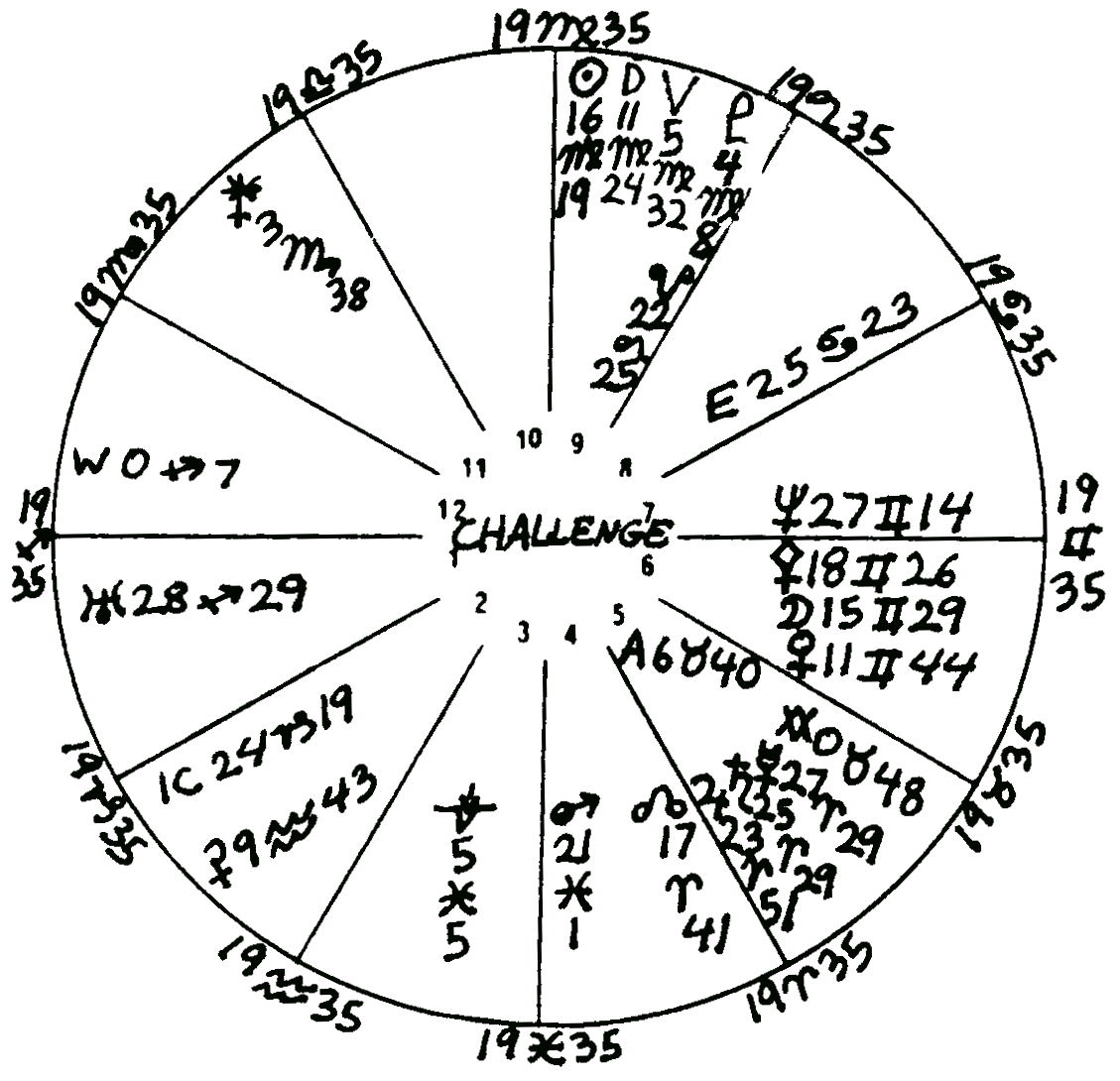New Games with Harmonics
Zip Dobyns
A general survey of some of the new work with harmonics was included in the first issue of The Mutable Dilemma. For those who joined our ranks after this first issue, I will try to recapitulate briefly the background of the area. Astrology started with five aspects, conjunction, sextile, square, trine, and opposition, or division of the circle by 1, 6, 4, 3, and 2. New aspects from Kepler and others added a division of the circle by 5, 8, and 12, all now in general use. A few astrologers divide the circle by 7, 9, and 11. Radio engineer John Nelson discovered still more aspects in his attempts to forecast the state of the ionosphere and its effect on short-wave radio transmission. Nelson reached an accuracy of 90% in his forecasts by using all multiples of 7 1/2, 11 1/4, and 18 degrees (divisions of the circle by 48, 32, and 20). He also confirmed the discovery of German astrologers that if a planet was located equidistant from two other planets (at their midpoint), the three planets were actually “in aspect” to each other, regardless of the actual number of degrees involved.
John Addey of England took the next logical step of asking “Why stop at those divisors?” Nelson had called his new aspects “harmonics” and Addey called his efforts “harmonic analysis.” Computer programs were developed by the English Astrological Association and by CCRS in Los Angeles in cooperation, to analyze data up to the division of the circle by 180, which would give an aspect of 2 degrees. But beyond the addition of more potential aspects, Addey suggested new techniques for dealing with charts. One technique was not so much new as an extension of a traditional Indian method. The Cosmobiologists of Germany, led by the Ebertins, were already using a 4th harmonic chart which they called the 90 degree dial; Edith Wangemann near Frankfurt was using a 30 degree dial; Dr. Landscheidt, a Cosmobiology student, had carried the idea down to a 7 1/2 degree dial, the 48th harmonic. The Indians have long emphasized a 9th harmonic chart which they call the Navamsa. In western terminology, this would be a 40 degree dial.
The procedure of calculating such a dial or harmonic chart is simple with a calculator or computer. Chart factors are converted from their degree in a zodiac sign to their degree in a 360 degree circle. For example, 6 degrees of Aries is 6, 6 degrees of Taurus is 36, 6 degrees of Gemini is 66, etc. In the second step, all factors to be used, including Ascendant, MC and other angles if desired, are multiplied by the harmonic number. In the third step, multiples of 360 degrees are subtracted from the results until the remaining figures are less than 360. These figures are converted back to sign and degree and can be placed in a chart wheel, using either equal houses from the new Ascendant or from the new (harmonic) Midheaven.
The Germans use these harmonic charts largely for assistance in seeing exact aspects, often ignoring signs and houses and simply using aspects including midpoints. Using the 90 degree dial (or 4th harmonic chart) one can see all conjunctions, squares, and oppositions as conjunctions; semi- and sesqui-squares (octiles and tri-octiles) appear as oppositions in the dial; other multiples of 22 1/2 degrees appear as squares in the chart. These particular aspects, the multiples of 22 1/2 degrees, have long been considered the “hard” aspects which are likely to indicate events in the life. The Uranian school of astrology, like the Ebertins originating in Germany, has been especially concerned with the prediction of events, and their work has emphasized this 16th harmonic which includes all multiples of 22 1/2 degrees. We can see some substantiation of the importance of these aspects when we realize that two of Nelson’s series hit all of these aspects—the multiples of 7 1/2 and of 11 1/4. Edith Wangemann’s 30 degree dial puts all aspects that are multiples of 30 degrees into a conjunction while 15 degree aspects appear as oppositions; 7 1/2 degree aspects appear as squares. Since one loses the distinction between the different aspects when squares, trines, etc. all appear as conjunctions, it is necessary to keep the original 360 degree chart on hand.
Moving to the less used harmonics such as the 7th, the 9th, the 5th, of course facilitates seeing the aspects involved. The fifth harmonic dial shows all quintiles as conjunctions. The tenth of the circle, the decile of 36 degrees will appear in the chart as an opposition while the 18 degree aspect, the 20th of the circle, will appear in the chart as a square. But the Indians did not use such charts as a means to see aspects quickly, as was the case in Germany. Indian astrologers used the various harmonic charts as keys to the area of life associated with the harmonic number. Thus, the 9th harmonic chart, the Navamsa, was interpreted as the soul urge or final goal of the life since 9 was the highest number before 10 started over as a higher octave of 1. Indian charts use the Ascendant sign as the first house, the next sign as the second, and so on. They do not appear to use the Midheaven chart. Addey carried this harmonic chart idea further, and explored the traditional meanings of the numbers in numerology through these harmonic charts. David Cochrane of Gainesville, Florida is also working with these ideas, and suggests that the 7th, 9th, 11th and 13th harmonics are associated with earthquakes, especially when multiplied by 4. The basic theory is that the harmonic chart portrays the facet of life symbolized by the number of the harmonic (the number used to divide the circle). According to David, the second harmonic chart (where oppositions and conjunctions are conjunct) is said to be a key to polarization and relationships; the fourth harmonic chart is taken as a key to the work needed to bring something to solid wholeness; the seventh involves training, taming and disciplining; etc. I’m not sure how that fits in with Addey’s association of the 7th harmonic and clergymen.
In addition to traditional Indian ideas, Addey offered a new theory; that the harmonic chart might be taken as a form of progression or direction with the harmonic number corresponding to the appropriate year of life; thus, 9th harmonic for 9th year; 20th harmonic for 20th year, etc. With either of these ideas, the harmonic chart is read as a horoscope, including sign and house placements and aspects, and not just as a quick way to see which planets have the aspects of that harmonic. Only a great deal more study of such charts can confirm whether these concepts are dependable, and one way to test their validity is through “blind analysis” of some of the charts to see whether they do, indeed, present accurate insights to the relevant period in the life or to the relevant portion of the character.
As indicated in the first issue of The Mutable Dilemma, we were disappointed in our initial tests of the harmonic variation called the arc transform. It had been suggested that the angular distance between two planets (or a planet and an angle) could be used to create a chart to throw additional light on the relationship between the chosen planets. For example, U.S.A. President Carter has his Saturn square his MC, so theoretically, a fourth harmonic chart would clarify or amplify the meaning of that square. Of course the two factors are not exactly square. Multiplying by the exact fraction of the circle, 3.85, produces a harmonic chart that puts Saturn and the MC exactly conjunct. A harmonic chart for the whole number (4) closest to that fraction gives very different results, moving almost all planets into the next sign and house. The whole number harmonic which puts Saturn and MC closest to exactly conjunct is #104, which of course produces a third, very different chart. Whether any of the three charts really throws light on Carter’s power is still an open question. Hitler’s Mars square Saturn produced an innocuous chart with a lot of air and mutables, and seemed of doubtful value. We are including the three variations of Carter’s Saturn-MC arc transform for you to see the differences possible with small variations. All are given as equal houses from the MC, but you can put them into the Ascendant chart if you wish.
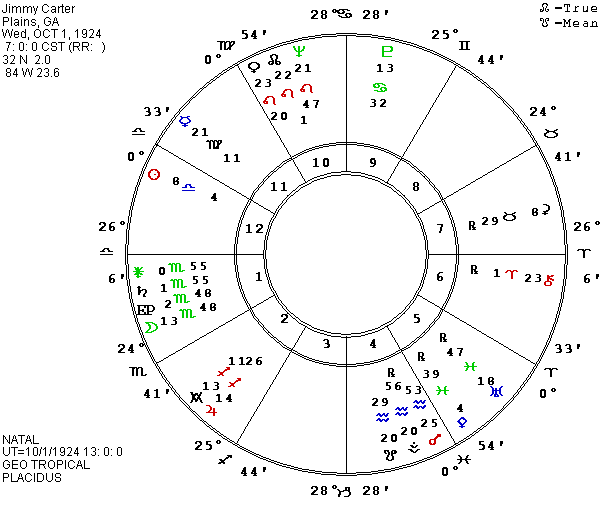
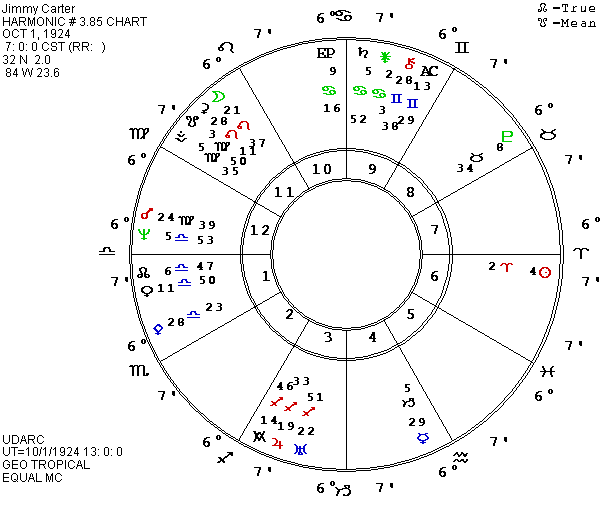

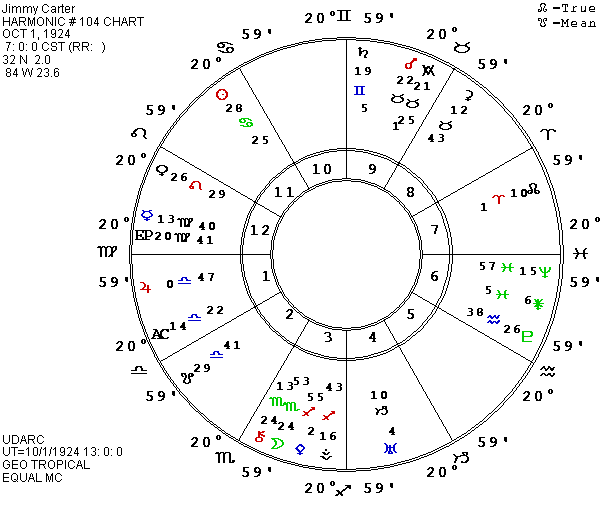
Similar variations occur in harmonic charts using the age of the individual for a chart to portray the whole year, versus charts drawn for a fraction of the year. We are including here, as examples of the possible variance, Jimmy Carter’s harmonic charts for age 53 (the year in which he was elected since he was 52 years old on October 1, 1976). Secondly, we offer the expansion chart for his solar arc at the time of the election. The solar arc is the distance between the natal (birth) sun and the secondary progressed sun at the time of the event, moving one day in the ephemeris for each year of life. Carter’s solar arc for the election was 51.99, so only a fraction of a degree different from his 52nd harmonic chart. Thirdly, we present Carter’s 52nd harmonic chart plus one month’s harmonic motion. (Fuller explanation later.) Since election to the presidency involves career and power (10th house matters), the equal house charts from the MC are given, but readers can easily set up Ascendant house charts.
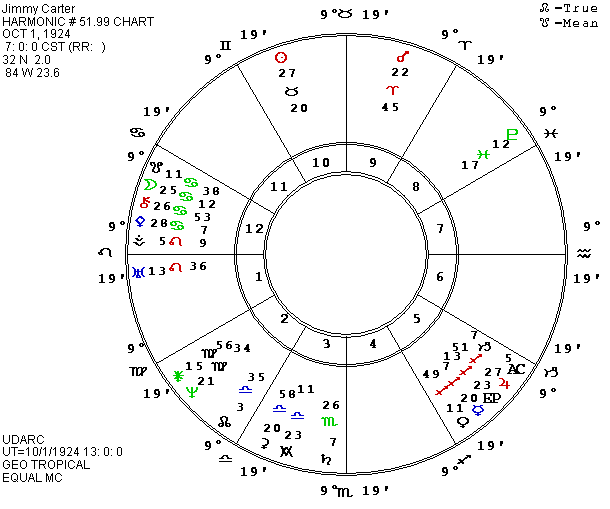
Note that the chart for the exact solar arc has the ruler of the equal-house Ascendant (Sun ruling Leo) in the 10th house, a very appropriate aspect for moving into personal power, while Jupiter is conjunct the harmonic Ascendant in Capricorn in the 5th house along with several factors in Sagittarius. The intense power struggle of the election is suggested in the position of Saturn in Scorpio opposite the MC, but the fire trines show the potential for achieving the personal desires. Vesta on the Ascendant of the MC chart also picks up the theme of focus on work, and Pallas conjunct the Moon and more widely conjunct Vesta can be interpreted as concern with social causes. I often find Pallas prominent in the charts of politicians or political activity. The T-square of Mars, Moon, and Ceres-Vertex-Antivertex could signify the home change (to the White House), as well as the media involvement, and the impossibility of reaching all the goals—ideals at war with the limits of the possible as one common form of the mutable dilemma. Neptune square the Sagittarius East Point and quincunx Mars in the 9th (Sagittarius) house repeats the theme. Note that in a fractional harmonic chart such as this one, multiplying by degrees and decimals rather than by a whole number, the angles can occur in any position.
Strictly speaking, this is not a harmonic chart but might be called an expansion chart. The same calculation method can be used; multiplication of original factors by the harmonic figure and subtraction of multiples of 360 until the final figure is less than 360. Or the closest multiple of the harmonic arc below the astrological factor expressed in the 360 degree circle may be subtracted from the factor before multiplying by the harmonic number. The astrological factor expressed in the 360 degree circle with the minutes converted to a decimal may also be divided by the harmonic arc (e.g. by 72 for the 5th harmonic) and the fractional remainder of the result then multiplied by the harmonic (e.g. by 5 for the 5th harmonic). Tables are also available from the Cambridge Circle so that the figures need not be calculated, and Neil Michelsen of Astro-Computing offers a page full of harmonics for a minimal price. Read Mark Pottenger’s article in the Gemini issue on the mathematics of harmonics for additional information if you want to experiment in the area.
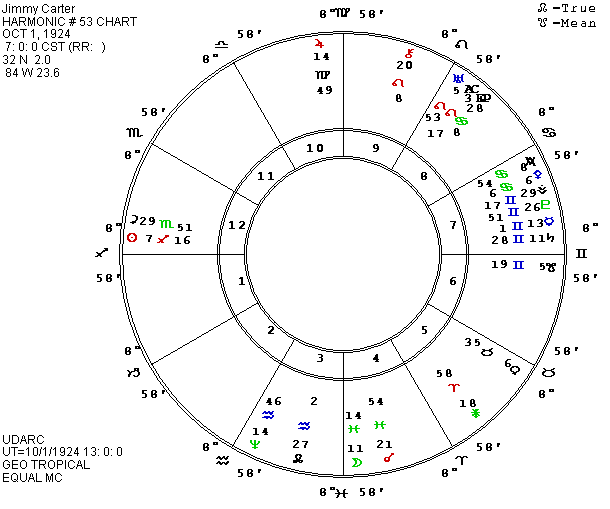
Jimmy Carter’s 53rd harmonic chart is also strong and favorable, using the equal house charts from the MC again since we are interested in status role and power. There are many conflicts such as Saturn square the MC, but Jupiter conjuncts the MC and rules the Ascendant in the MC houses, while the Sun is closely conjunct that Ascendant in Sagittarius, and is trine Uranus and the Harmonic Ascendant. Venus also rules the 10th house since Libra is included in the house, and it trines the MC from the 5th house of power and prominence. There are many mutable squares and oppositions, foreshadowing the conflicts over principles and values which have become so much a part of the experience of the administration, with the loaded 7th and 8th houses indicating the heavy power struggles of the election and the days to come. But it still looks like a successful effort.
Laura Ruben of Hammond, Indiana suggested a third way to work with harmonic charts to try to pinpoint more precisely the events during a year. Using a single chart for a whole year opens up the same problem I found in working with solar return charts. They did not seem helpful in timing, and they were too static to accurately portray any period as complex as a whole year. Others have of course had the same reaction, and have developed methods of progressing solar returns, Wynn’s being the best known. Laura Ruben’s suggestion is similar to Wynn’s treatment of the solar return angles, and makes logical sense. She calculates the change in each factor, from one harmonic position to the next, divides the interval by twelve, and adds the amounts to give new monthly positions through the year.

When we apply the method to Jimmy Carter’s election, we take his 52nd harmonic chart as his state on his 52nd birthday and add one twelfth of the difference between each planet in that chart and the position of the planet in the 53rd harmonic chart, since the election occurred just one month and one day after his birthday. Of course the amount of movement depends on the original position of the planet in the natal chart. Planets that are in early signs will move less, since we are multiplying the planet’s degree in a 360 degree circle by the harmonic number. If a planet is at 5 Aries, its fifth harmonic position will only move to 25 Aries. If a planet is at 5 Taurus, its fifth harmonic position will be 5 times 35, so it will move to 25 Virgo. If we wanted a progressed harmonic chart for one month after the fifth birthday, using this technique, the first planet would move only a fraction of a degree. The second one would move almost 3 degrees.
You can calculate your own monthly harmonic movement by simply dividing each planet’s position in the 360 degree circle by 12. Division by 52 would give the weekly movement. Daily movement can be derived the same way by dividing the original position by 365, if the planet is late enough in the zodiac to make this worth while. As you can see, the movement is proportional to the natal position, though the actual positions constantly vary in their relationship to each other. If all these systems do somehow manage to portray the basic themes of the person and her/his destiny, it seems more and more obvious that we are not dealing with specific influences and detailed results. We are looking at a deep meaning which can be expanded and contracted in many ways, so long as the treatment is systematic; the same proportions maintained for the whole chart.
[Archivist’s note: this technique can be explored in any horoscope program that allows you to work with charts for non-integer harmonics. Include the fraction of a year in the decimal part of the harmonic, as in the 52.083 example above for 52 + 1/12th.]
Is it just another game? Only much more work will tell us. In the meantime, here is the chart for Jimmy Carter at age 52 plus one month, using equal houses from the MC. Does it look like a man being elected to the U.S. presidency? It is a strong chart, with Sun (ruler of the Ascendant in the MC chart) in the tenth house, along with Mars, the natural ruler of the first house. Venus in the Sun’s house trines the Ascendant, while Jupiter and the harmonic Ascendant are in Capricorn in a grand trine to the MC and Uranus in Virgo. Earth trines suggest success in handling the physical world; career, status, achievement. Fire trines suggest ability to go after and get what the individual wants. There is also a grand trine in water, including Saturn, Pluto, and north node of the Moon. Water suggests harmony within the unconscious, and ability to receive help from other than personal efforts. Sun and Moon are sextile, further supporting harmony between unconscious security needs and ego drives. Pallas rising fits involvement in politics and social causes, while Vesta in the first house points to the workaholic tendencies, and Uranus in the first is appropriate for someone likely to do unconventional things, and to be concerned with democracy and human rights. Obviously, there are many conflict aspects as well, showing the stress and struggles of the position he was seeking, but the chart does seem appropriate for a winner of high position.
Much more work will be needed to validate such charts as dependable tools in astrological work. These three charts were selected to permit readers to see the striking differences between charts for the approaching year of age, for the exact age (year plus months into the year), and for the exact solar arc of the event. Carter was 52 when he was elected, and Addey has seemed uncertain whether the 52nd or the 53rd harmonic was more appropriate. In our experience to date, the harmonic of the next birth date seems more accurate, but the solar arc seems even better. In Carter’s case, the solar arc chart is too close to the 52nd harmonic to throw light on Addey’s question of 52nd versus 53rd.
Nancy Madsen of Racine, Wisconsin is responsible for our investigation of the solar arc harmonic charts, and so far, a number have proved remarkably appropriate. In one case of a divorce after many years of marriage, Uranus exactly opposed the Ascendant in the solar arc harmonic chart. In another harmonic chart for the solar arc of a marriage break, Pluto was conjunct the MC within 18 minutes; Saturn was conjunct the East Point within 16 minutes; Neptune opposed the Ascendant within 11 minutes; and an incredible pile of planets were in fire signs in water houses, showing the intense emotionality of the period. The harmonic chart for my solar arc at the death of my father had Saturn and Moon conjunct in the 12th house opposite the Sun and quincunx Mars. The Sun was also quincunx a Vesta-Mercury conjunction which was also square the MC. Uranus-Juno-West Point opposed Neptune-Pluto, plus many other aspects. The harmonic chart for the solar arc of a woman when she died from lupus repeated the theme of the natal chart which showed the danger of some sort of illness from repression of basic aggression and self-assertion. Gemini was rising, as in the natal chart, and Mercury its ruler was in the 8th house exactly tri-octile the Ascendant. Also, Mars was in the first house in Gemini, as in the natal chart, but square Jupiter and Neptune in Pisces in the tenth house. Her natal chart had a heavy 12th house and Pisces, symbolizing her attempt to be saintly which resulted in the emotional repression that permitted the illness.
Since the solar arc charts change so radically, so quickly, this is obviously not a technique which can be used for forecasting, though a computer could calculate the times when planets and angles would form precise aspects. Perhaps the technique is only a game. Hindsight is much easier than foresight, and one can almost always find something to fit when the situation in the life is known. The only way to test the usefulness of a technique is through blind analysis, so we will end this article with three more charts—all harmonic charts from solar arcs. Readers are invited to send in their theories on the psychological state of each individual at the time of the solar arc. All subjects are male. Were they happy or sad? What areas of life are emphasized? Consider this an extra challenge corner for this issue and let us know what you think about the potentials of the technique. We’ll print the nature of the events connected with these charts in the next issue of The Mutable Dilemma.

